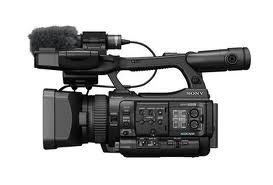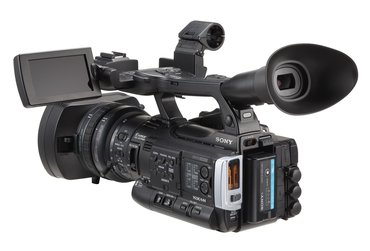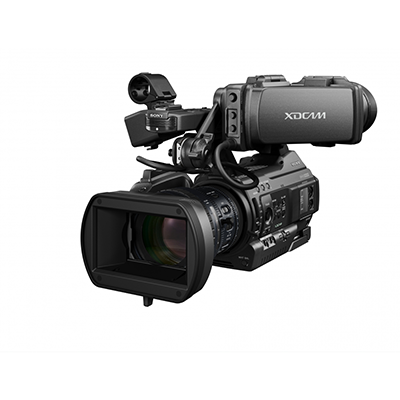XDCAM EX
Sony PMW 100
June/19/12 12:52 Filed in: Video Cameras
It's a spiff unit - but a pretty small chip.

Might be a good replacement for the Panasonic AX-100 - level stuff. Would like to go HD with all clients, but not for free!
One thing to pay attention to on these new cameras is that some are 3-chip and some are 1. Traditionally that was how you could tell a pro camera from a consumer. Like the EX1 is (3) 1/2" chips. Stuff like the Sony FS100/700/F3, etc. are competing with large DSLRs, so they are 1 LARGE chip. The PMW 100 is (1) slightly-larger-than ⅓” chip (1/2.9"), so I dunno how that will perform. Certainly they're making great strides in that area. And the onboard 50Mbps XDCAM recording capability is cool - wouldn't necessarily need an outboard recorder. It'll be interesting to see some footage from it.

Might be a good replacement for the Panasonic AX-100 - level stuff. Would like to go HD with all clients, but not for free!
One thing to pay attention to on these new cameras is that some are 3-chip and some are 1. Traditionally that was how you could tell a pro camera from a consumer. Like the EX1 is (3) 1/2" chips. Stuff like the Sony FS100/700/F3, etc. are competing with large DSLRs, so they are 1 LARGE chip. The PMW 100 is (1) slightly-larger-than ⅓” chip (1/2.9"), so I dunno how that will perform. Certainly they're making great strides in that area. And the onboard 50Mbps XDCAM recording capability is cool - wouldn't necessarily need an outboard recorder. It'll be interesting to see some footage from it.
Comments
The new Sony PMW 200
June/20/12 12:50 Filed in: Video Cameras
It’s pretty bitchin’

People have been complaining that they aren't putting pro codecs in these awesome cameras they're coming out with - like the FS100 and 700. Why a so-so AVCHD onboard codec, and not an established pro codec like XDCAM? Even the EX1 and EX3 are XDCAM EX 4:2:0 at 35 Mbps. This little unit is XDCAM 4:2:2 at 50 Mbps! Cool!
Again, though, I would like to see what this (new, I think) sensor looks like. Assuming it doesn't suck, the camera looks like a sure-thing-type good investment. TC in/out, Genlock in/out, SDI out…. it will likely get a lot of use in multi cam shoots due to the connectivity alone.
The big question is, "Where is the PMW-EX5?". Many expect that to be the next thing to drop.

People have been complaining that they aren't putting pro codecs in these awesome cameras they're coming out with - like the FS100 and 700. Why a so-so AVCHD onboard codec, and not an established pro codec like XDCAM? Even the EX1 and EX3 are XDCAM EX 4:2:0 at 35 Mbps. This little unit is XDCAM 4:2:2 at 50 Mbps! Cool!
Again, though, I would like to see what this (new, I think) sensor looks like. Assuming it doesn't suck, the camera looks like a sure-thing-type good investment. TC in/out, Genlock in/out, SDI out…. it will likely get a lot of use in multi cam shoots due to the connectivity alone.
The big question is, "Where is the PMW-EX5?". Many expect that to be the next thing to drop.
Sony PMW 200
September/01/12 12:44 Filed in: Video Cameras
Some pros and cons on the new Sony camera

$7,800 list price. The EX-1 listed for around that but sold for $6,500. I think the earlier numbers were guesstimates of the street price.
Yeah - not exactly cheap. B&H is listing it for $6,300. Plus cards and batts and etc. But it's the same price as the EX-1 was back when I bought it, so not terrible. And you don't have to buy a lens, and can likely get by without an external recorder.
The only thing that's a bit of a bummer (for me, if I was to consider it as a replacement for my EX-1) is that it is essentially the same chips and lens as the EX-1 with some added features and better on-board recording. So it's not like I would be getting better quality from the main guts of the thing. Yes, the recordings going to the cards would be better, but with the Samurai, I am already getting 4:2:2 AND even higher-bitrate ProRes, so I can technically make better recordings with my existing camera.
If I didn't already own the EX-1, though, I would definitely put it high on the consideration list.
The integration with 'pro' XDCAM stuff will be big for a lot of folks. It should make it easier to do dailies and archives to BD, which I would really like. I'm finding myself wishing I had an easy way to burn discs of the raw footage I shoot on the thing. I have already lost some original footage by mistakenly erasing the wrong hard drive (the one with the ONLY backup on it - AFTER I had re-used the cards).
So just having it on hard drives still makes me nervous, even if I have two copies. After a year or so, you start looking back through the HDs and going, "hey there's a bunch of space on this one, what if I moved this over here, blah blah…" and pretty soon you don't know what you've got or where it is. Clearly I need better data management skills. If it's burned to a shiny disc though, it's locked down for at least a decade - it's more like having a tape master backup. I think a lot of pro environments are still using DLT tape, but unless that has changed significantly, it takes forever. I guess you just leave it running overnight.

$7,800 list price. The EX-1 listed for around that but sold for $6,500. I think the earlier numbers were guesstimates of the street price.
Yeah - not exactly cheap. B&H is listing it for $6,300. Plus cards and batts and etc. But it's the same price as the EX-1 was back when I bought it, so not terrible. And you don't have to buy a lens, and can likely get by without an external recorder.
The only thing that's a bit of a bummer (for me, if I was to consider it as a replacement for my EX-1) is that it is essentially the same chips and lens as the EX-1 with some added features and better on-board recording. So it's not like I would be getting better quality from the main guts of the thing. Yes, the recordings going to the cards would be better, but with the Samurai, I am already getting 4:2:2 AND even higher-bitrate ProRes, so I can technically make better recordings with my existing camera.
If I didn't already own the EX-1, though, I would definitely put it high on the consideration list.
The integration with 'pro' XDCAM stuff will be big for a lot of folks. It should make it easier to do dailies and archives to BD, which I would really like. I'm finding myself wishing I had an easy way to burn discs of the raw footage I shoot on the thing. I have already lost some original footage by mistakenly erasing the wrong hard drive (the one with the ONLY backup on it - AFTER I had re-used the cards).
So just having it on hard drives still makes me nervous, even if I have two copies. After a year or so, you start looking back through the HDs and going, "hey there's a bunch of space on this one, what if I moved this over here, blah blah…" and pretty soon you don't know what you've got or where it is. Clearly I need better data management skills. If it's burned to a shiny disc though, it's locked down for at least a decade - it's more like having a tape master backup. I think a lot of pro environments are still using DLT tape, but unless that has changed significantly, it takes forever. I guess you just leave it running overnight.
Still cameras for video
January/30/13 12:34 Filed in: Video Cameras
My thought is still to use a video camera for video. Too many hassles and compromises with using still cameras for video.
It's cool if you are a still photographer who has a lot invested in lenses and you want to get into video, but if you're starting from scratch, the extra stuff you need will end up driving the cost up to the level of a dedicated video camera, and then it's not an integrated system.
This is the big problem with this whole trend toward what I might call 'mini-Cine' rigs - there's a lot of stuff and expense aside from the camera head itself. Which is why for most of us, a PMW-type camera is ideal. I mean, unless you really have a NEED for the interchangeable lenses that you get paid for (and will mostly be working cine-style).
It's cool if you are a still photographer who has a lot invested in lenses and you want to get into video, but if you're starting from scratch, the extra stuff you need will end up driving the cost up to the level of a dedicated video camera, and then it's not an integrated system.
This is the big problem with this whole trend toward what I might call 'mini-Cine' rigs - there's a lot of stuff and expense aside from the camera head itself. Which is why for most of us, a PMW-type camera is ideal. I mean, unless you really have a NEED for the interchangeable lenses that you get paid for (and will mostly be working cine-style).
Sony PMW 300
June/24/13 12:31 Filed in: Video Cameras

I have a feeling that the new Sony PMW-300:
1) It should be a good solid camera that may have a useful lifespan
2) It's too little too late in some ways
The improvements over the existing EX cameras are incremental. I had frankly hoped for some sort of merging of the EX's with the Fs700 or something along those lines, but I guess the EX-type camera is stuck being a half-inch, three-sensor deal. I've been meaning to do some research on the tradeoffs between 3 chip and the big single chip cameras.
It certainly is nice to have 4:2:2 onboard recording, since regular XDCAM EX is getting long in the tooth, but it's not a huge difference, and I would still use it as simultaneous-record backup. Once you go direct to ProRes, it's pretty hard to go back unless you have to. But for those shooting handheld, and those shooting for Euro broadcast, it certainly makes sense.
The big question mark in my mind is, what will the implementation of the future XAVC codec upgrade be? They are using that codec now in the F5 and F55. Since it already will have 422 50Mbps recording, I'm assuming it will be the 444/ up to 300Mbps flavor. That will likely require buying all new high speed cards to handle the data rate. Plus the rest of the workflow that goes with it - which admittedly is less onerous than much of the 4k & RAW crap that's going on at the moment.
Speaking of which, I've been reading a lot the press and blogs about 4k and RAW, and I really don't see the need for either for a vast majority of shooters - unless you have a client who wants to pay for it, or you want it for your own project. You pay a big price in terms of data rate, cards, hard drives, editing, money, etc. for differences most people can't see. The compressed codecs are just too good for the most part. Hell, I'm still shooting all 720p60, and my clients think it looks awesome. Depends on what you're used to.
The other thing I wonder about XAVC is, being another implementation of H.264, what is its future once H.265 hits the real world? The codec (aka HEVC - high efficiency video codec) has been officially released, and so it should just be a matter of time before it is implemented in cameras and such. H.264 is 10 years old now. H.265 is half the data rate for the same quality (allegedly).
